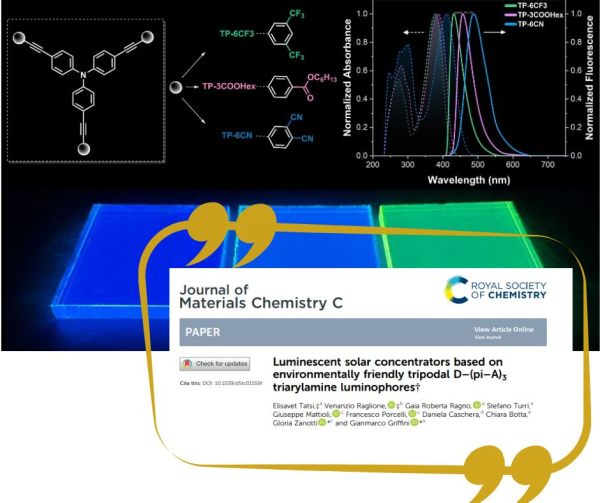A research team from CNR-ISM, CNR-SCITEC, CNR-ISMN and Politecnico di Milano has published in the journal Journal of Materials Chemistry C a multidisciplinary study integrating sustainable synthesis, advanced photophysical characterization, and device implementation, with a focus on luminescent solar concentrators (LSCs), transparent devices that capture sunlight and convert it into energy, ideal for smart windows and building façades. The researchers developed three new triphenylamine-based luminophores, synthesized via a sustainable three-step route using non-toxic solvents (propan-1,2-diol) and room-temperature conditions. This approach enabled very high overall yields (up to 86%) and a low environmental impact in terms of waste production (total E-factor <190), aligning with green chemistry principles. The luminophores were embedded in PMMA matrices to fabricate highly transparent LSCs (AVT ~90%). The resulting devices exhibited excellent optical performance, with internal photonic efficiencies up to 50% and external ones exceeding 5%, among the highest values ever reported for transparent organic LSCs. The materials also showed outstanding photothermal stability and minimal spectral overlap between absorption and emission, crucial to minimize reabsorption losses. These results highlight the potential of TPA-based systems for building-integrated photovoltaics, where aesthetics, sustainability, and performance must go hand in hand. This work paves the way for future development of efficient, low-impact, large-area LSCs.
The authors gratefully acknowledge fundings from the Italian Ministry of University and Research (MUR) (PRIN 2022 Prot. 2022BREBFN, project: NIR+), Fondazione Cariplo (Ref. 2023-1656, project: PHASMA), ICSC-Centro Nazionale di Ricerca in High Performance Computing, Big Data and Quantum Computing, funded by European Union-NextGenerationEU (grant CN00000013), HORIZON EUROPE under the project ‘‘Fast plasma-assisted perovskite crystallization for high efficiency lead-free perovskite thin film photovoltaics’’ (SMARTLINE PV), grant agreement no. 101122327.
